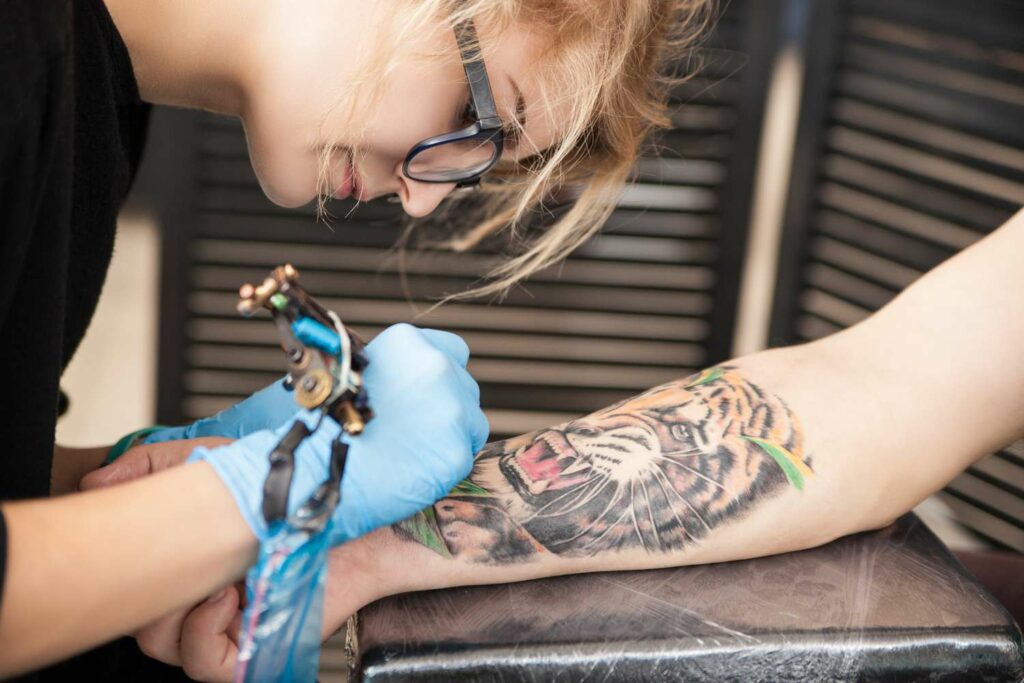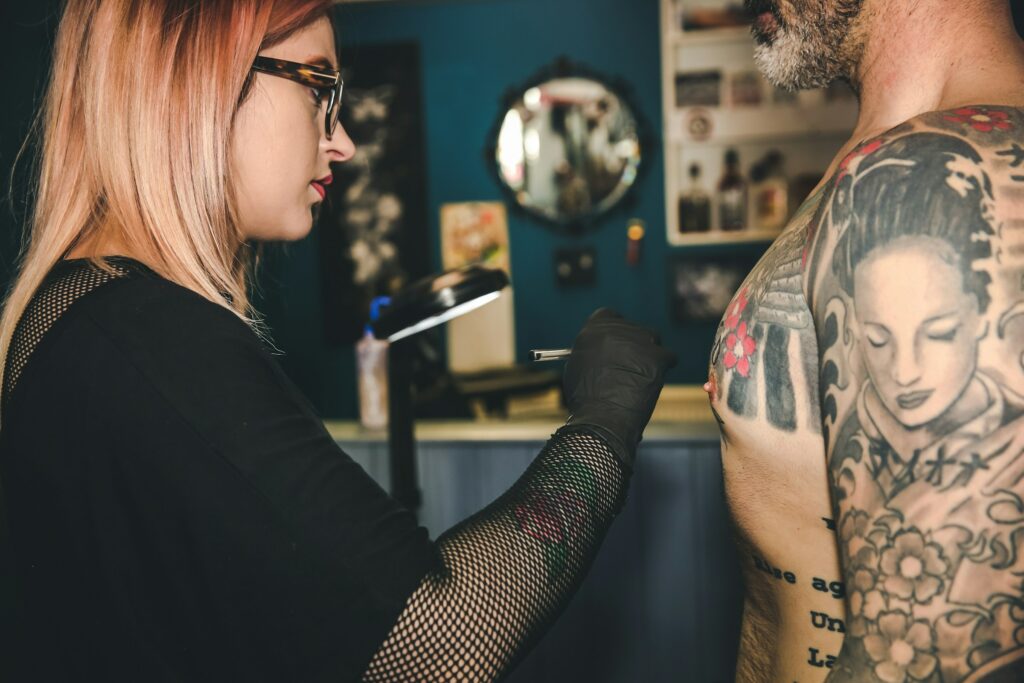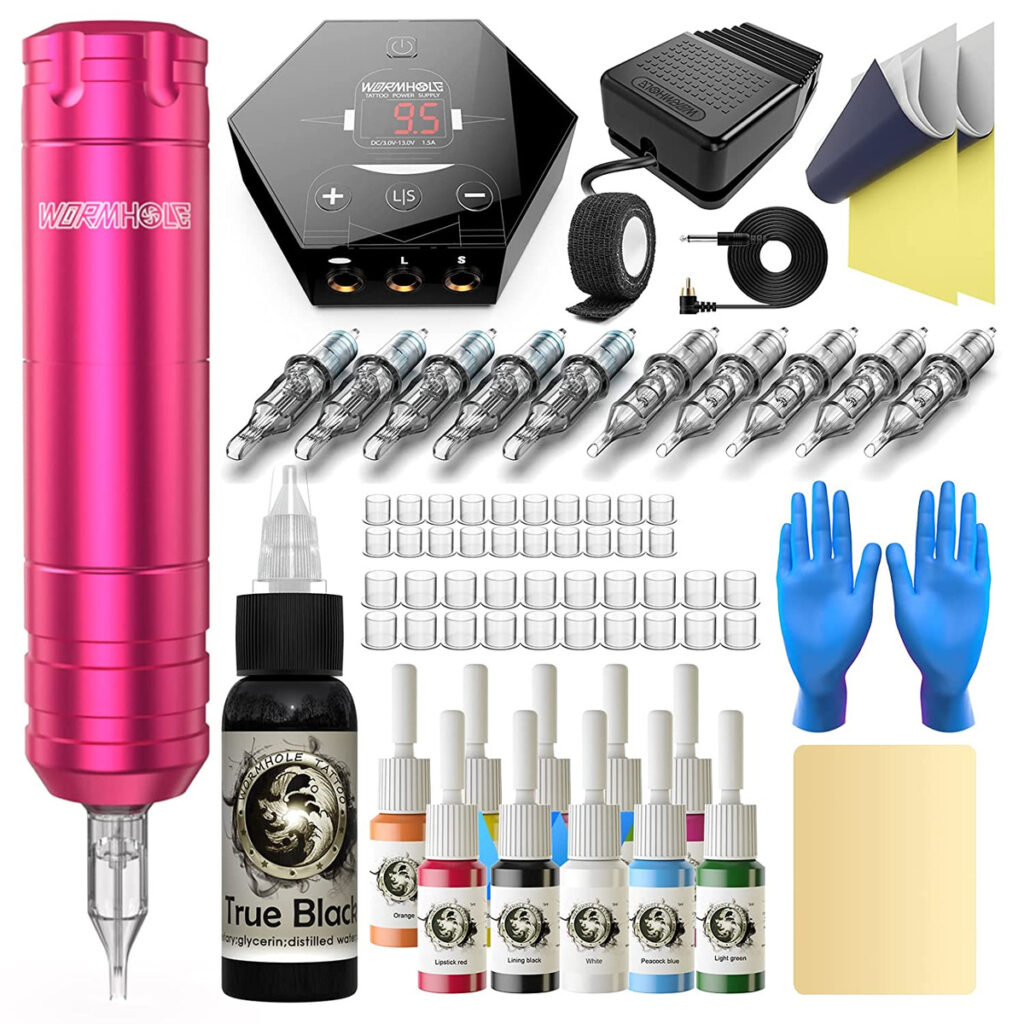Tattoo Techniques – Guide for All Levels. Tattooing is an ancient art form, evolving over centuries to become the sophisticated practice it is today. Mastering various tattoo techniques is crucial for anyone in the field, from aspiring tattoo artists to seasoned professionals. This guide will explore essential techniques that cater to all skill levels, helping you enhance your craft and deliver exceptional tattoos. It will cover everything from basic to advanced techniques, traditional styles, and modern methods, providing valuable insights for improving your tattooing skill levels.
Basic Tattoo Techniques
Lining Techniques

Lining is the foundation of any tattoo, as clean lines define the structure and detail of the design. Achieving precise line work requires steady hands, the right equipment, and meticulous attention to detail. Here are some detailed tips for improving your lining technique:
- Use a High-Quality Liner Needle:
- Ensure you select a liner needle that is well-suited for creating crisp, clean lines. High-quality needles reduce the risk of ink splatter and inconsistent lines.
- Maintain Consistent Pressure and Speed:
- Consistency is key when it comes to lining. Apply even pressure and maintain a steady hand to create smooth, continuous lines.
- Practice on Synthetic Skin:
- Develop a steady hand and perfect your technique by practicing on synthetic skin. This helps build confidence and precision before working on real skin.
Shading Techniques
Shading adds depth and dimension to tattoos, creating a realistic and dynamic effect. There are different shading techniques, each suited to specific styles:
- Whip Shading:
- Technique: Create soft gradients by moving the needle in a whip-like motion.
- Best For: Achieving smooth transitions and subtle shading effects.
- Circular Shading:
- Technique: Use circular motions to build up layers of ink gradually.
- Best For: Areas that require smooth and even shading, ensuring consistent ink coverage.

For effective shading, choose the right tools and needles, such as magnum shaders, which are designed for broad and smooth shading.
Color Packing Techniques
Color packing involves applying solid colors to the skin, creating vibrant and lasting tattoos. It requires a thorough understanding of color theory and precise application techniques:

- Use Round Shaders or Magnum Needles:
- Select round shaders or magnum needles for dense color packing. These needles allow for efficient ink saturation and even color distribution.
- Work in Small Sections:
- To ensure even color distribution, work in small sections. This allows for better control and reduces the risk of patchiness.
- Layer the Ink Carefully:
- Address common challenges like patchiness by carefully layering the ink. Apply multiple passes if necessary to achieve a uniform and vibrant color.
Advanced Tattoo Techniques
Dotwork and Stippling Techniques
Dotwork tattoos consist of numerous small dots that form intricate patterns and designs. Stippling is a similar technique used for creating shading and texture.

- Needle Selection:
- Use a single needle or a tight round liner for precise dotwork. These needles help create consistent, fine dots.
- Consistency in Dot Spacing and Size:
- Practice maintaining uniform dot spacing and size to achieve a cohesive and balanced design. Consistency is key to professional-looking dotwork.
- Design Choice:
- Opt for geometric shapes and mandalas to create stunning dotwork pieces. These designs leverage the repetitive nature of dotwork for visual impact.
Black and Grey Techniques
Black and grey tattoos utilize varying shades of black ink to create realistic images with depth and contrast.

- Smooth Shading Transitions and Gradients:
- Focus on achieving smooth transitions and gradients between different shades of black. This technique enhances the three-dimensional appearance of the tattoo.
- Use of Diluted Black Ink (Wash):
- Incorporate diluted black ink, also known as wash, to create lighter shades and highlights. This method allows for a wide range of tonal variations.
- Balancing Contrast and Depth:
- Balance contrast and depth to enhance the realism of the tattoo. Proper shading techniques and attention to detail are essential for creating lifelike images.
Watercolor Tattoos Techniques
Watercolor tattoos mimic the appearance of watercolor paintings, featuring fluid and blended colors.
- Blending Colors Seamlessly:
- Use a light touch and fluid motion to blend colors seamlessly. This technique helps create the soft transitions characteristic of watercolor art.
- Incorporating Artistic Elements:
- Incorporate splashes, drips, and gradients to achieve a painterly effect. These elements add to the organic feel of watercolor tattoos.
- Avoiding Outlines:
- Avoid using outlines to maintain a softer, more organic look. The absence of harsh lines allows for a more fluid and natural appearance.
Traditional Tattoo Techniques

American Traditional Techniques
American Traditional tattoos are distinguished by their bold lines, vibrant colors, and iconic motifs such as anchors, roses, and eagles. This style emphasizes clear and striking visuals with minimalistic elements.
- Emphasize Strong Outlines:
- Focus on creating thick, bold outlines that define the tattoo’s structure. Strong outlines are a hallmark of the American Traditional style and help the design stand out.
- Minimal Shading:
- Use minimal shading to maintain the bold and clear look. When shading is used, it is often simple and limited to create depth without overpowering the solid colors.
- Limited Color Palette:
- Stick to a limited color palette, primarily using primary colors like red, blue, and yellow. This approach keeps the design straightforward and striking.
- Classic Motifs and Designs:
- Incorporate classic motifs such as anchors, roses, eagles, skulls, and daggers. These iconic symbols are integral to American Traditional tattoos and are often chosen for their timeless appeal and bold representation.
Japanese Irezumi Techniques
Irezumi is the traditional Japanese tattooing style, renowned for its intricate designs and deep symbolic meanings. These tattoos often cover large areas of the body and are rich in cultural significance.
- Study the History and Cultural Significance:
- Understand the historical context and cultural importance of Irezumi. Knowledge of its origins and evolution will enhance the authenticity and meaning behind the designs.
- Use Traditional Motifs:
- Incorporate traditional Japanese motifs such as koi fish, dragons, cherry blossoms, tigers, and geishas. These elements are deeply symbolic and often tell a story or convey a particular meaning.
- Focus on Large-Scale Designs:
- Design tattoos that cover significant parts of the body, such as the back, chest, or full sleeves. Irezumi tattoos are known for their expansive and cohesive compositions that flow with the body’s natural lines.
- Intricate Detailing:
- Pay attention to intricate details and fine line work. Irezumi tattoos are celebrated for their elaborate designs and meticulous craftsmanship, which require a high level of skill and precision.
Tattoo Machines
Choosing the right tattoo machine is crucial for executing various techniques effectively.

- Rotary Machines: Ideal for smooth shading and color packing due to their consistent needle movement.
- Coil Machines: Known for their power, making them suitable for precise line work.
- Select the appropriate machine based on the technique you aim to master.
Needles and Cartridges
Different tattoo techniques require specific types of needles.
- Liner Needles: Perfect for creating crisp lines.
- Shader Needles: Suitable for smooth shading and color filling.
- Ensure proper maintenance and sterilization of needles to uphold hygiene and safety standards.
Tips for Mastering Tattoo Techniques
Practice on Synthetic Skin
Using synthetic skin allows you to hone your skills without the pressure of working on a real client.
- Experiment with different techniques and designs.
- Build confidence and precision before transitioning to human skin.
Continuous Learning
Tattooing is an ever-evolving art form, and staying updated with the latest techniques and trends is essential.
- Attend workshops, conventions, and training sessions.
- Network with other tattoo artists and learn from their experiences.
Safety and Hygiene
Maintaining a sterile environment is paramount in tattooing to prevent infections and ensure client safety.
- Follow best practices for sanitation and sterilization.
- Use disposable gloves, needles, and other supplies to minimize contamination risks.
FAQs
1.What are the most common tattoo techniques?
- Common techniques include lining, shading, color packing, dotwork, and black and grey shading.
2. How can I improve my line work in tattoos?
- Practice regularly on synthetic skin, maintain consistent pressure and speed, and use high-quality liner needles.
3. What equipment is best for advanced shading techniques?
- Magnum shader needles and rotary machines are ideal for smooth and even shading.
4. Are there specific techniques for different tattoo styles?
- Yes, different styles like American traditional, Japanese Irezumi, realism, and geometric tattoos each require unique techniques and approaches.
Conclusion
Mastering various tattoo techniques is a journey that requires dedication, practice, and a continuous desire to learn. By understanding and applying the techniques covered in this guide, you’ll be well on your way to becoming a proficient and versatile tattoo artist. Remember, the key to success lies in constant improvement and a willingness to embrace new challenges.
As you embark on your tattooing journey, keep exploring, practicing, and refining your skills. The world of tattooing is vast and ever-changing, offering endless opportunities for creativity and growth.



Thanks for sharing this amazing article! I’m so inspired to learn more about tattooing.
Wow, this is an incredibly informative article! I’ve learned so much about different tattoo techniques. Thanks for sharing!
I’ve been tattooing for a few years now, and I can definitely say that the techniques mentioned in this article are essential for creating high-quality tattoos.
I’m interested in learning more about [specific technique]. Can you recommend any resources for further learning?
I’m not sure if I’m brave enough to try [technique]. It looks like it could be really painful!
This article couldn’t have come at a better time! I was just about to dive into getting my first tattoo, and now I feel much more informed about the techniques involved. Thanks for sharing these valuable insights!
Having practiced tattooing for a few years, I can vouch for the importance of mastering the techniques outlined in this article. They truly are fundamental for achieving top-notch results. Great job on compiling this resource!
Thanks for shedding light on these essential tattooing techniques! As someone eager to learn more about the craft, I’ll definitely be exploring your other articles to deepen my understanding. Keep up the fantastic work!
This article is a goldmine of knowledge! I had no idea there were so many different tattoo techniques out there. Thanks a bunch for sharing this valuable information!
After a few years in the tattooing scene, I can’t stress enough how crucial it is to master the techniques outlined in this article. They truly lay the foundation for creating exceptional tattoos.